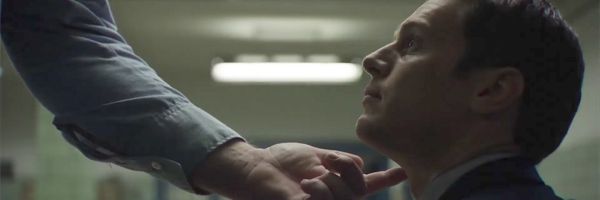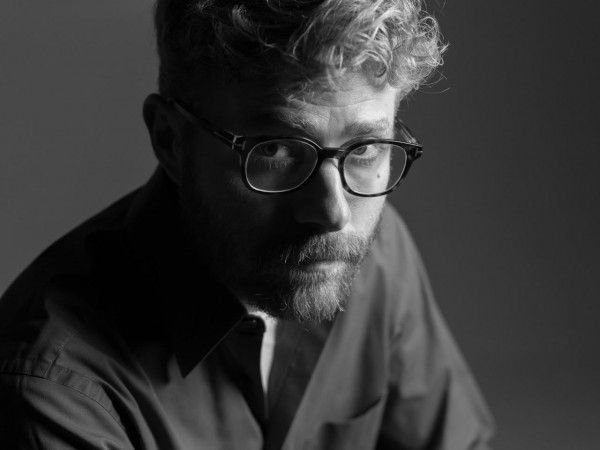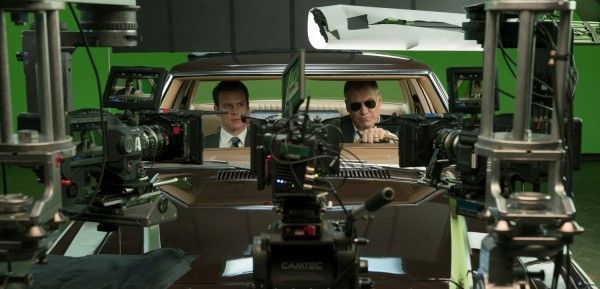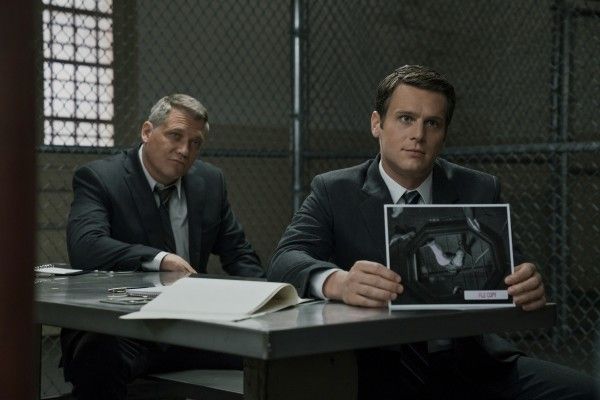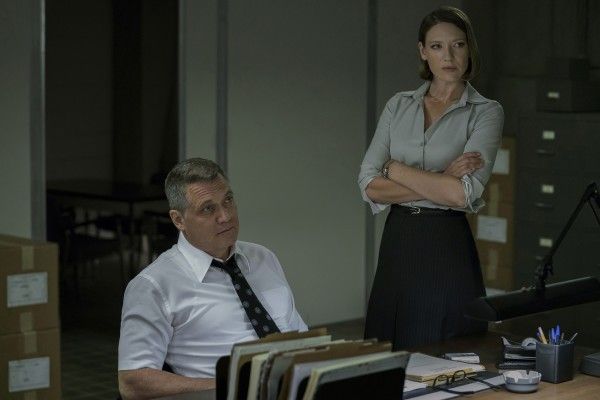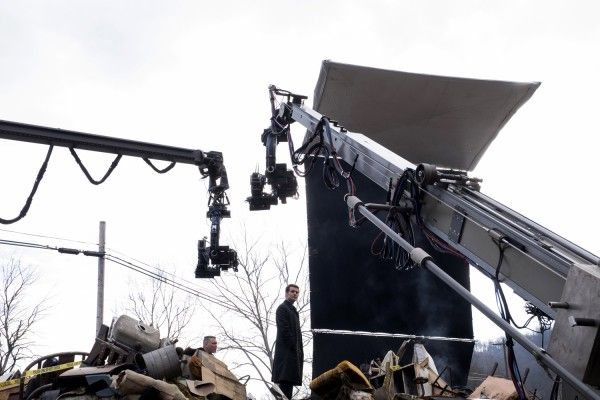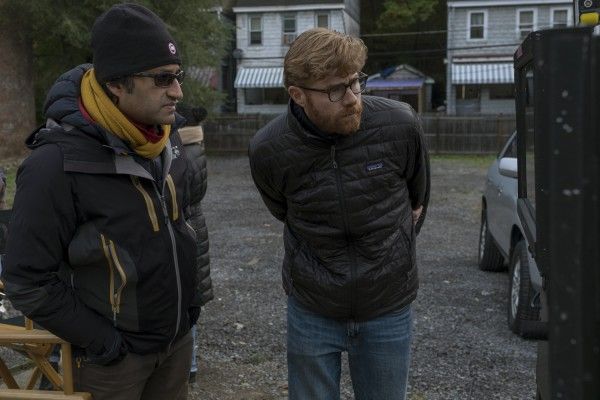The Netflix original series Mindhunter is, by far, one of the best new shows currently running. The true story-based, 1977-set drama chronicles the early days of criminal psychology and criminal profiling primarily through the eyes of three people at the FBI’s Behavioral Science Unit: eager newcomer Holden Ford (Jonathan Groff), somewhat jaded veteran Bill Tench (Holt McCallany), and brilliant psychology professor Wendy Carr (Anna Torv). That this show is immaculately crafted from top to bottom will come as no surprise to those aware that it’s the brainchild of David Fincher, who serves as executive producer and directed nearly half of the series’ first season.
This is without doubt one of the best looking pieces of entertainment released in 2017, regardless of medium, with classical framing, motivated camera movement, and a tremendous palette that gives a mere peek into the darkness inside the minds of the criminals and serial killers who are the subject of the Behavioral Science Unit’s interviews.
So when I got the chance to speak with cinematographer Erik Messerschmidt about his work on the series, I was thrilled. Messerschmidt shot eight of the first season’s 10 episodes, including the Fincher-directed closing installments, and as he revealed during our interview, this was essentially his first major gig as a cinematographer. Messerschmidt had worked previously as a gaffer on shows like Mad Men and Bones, and then later the feature film Gone Girl where he first came into contact with Fincher. Based on their work together on that film, Fincher called Messerschmidt up when they were looking for a new DP for Mindhunter after the show’s original cinematographer exited over creative differences.
This promotion from gaffer to DP is a familiar refrain with Fincher’s cinematographers, as he did the same with his The Game and Fight Club gaffer Claudio Miranda, who was brought on as DP for The Curious Case of Benjamin Button and went on to win the Oscar for Best Cinematography for his work on Life of Pi.
Messerschmidt’s rise to the primary cinematographer of Fincher’s brand new TV show elicits similarly spectacular results, as the DP’s work on Mindhunter is elegantly classical and incredibly motivated by character and theme. During the course of our conversation, Messerschmidt talked about the road that led to him becoming the cinematographer on Mindhunter, the specifics of his working relationship with Fincher, what it’s like to serve as a DP in the world of episodic television, how the work of production designers and costumes designers goes under-appreciated, and trying to maintain a consistent aesthetic with multiple directors. He also teased a bit about Mindhunter Season 2, including revealing their extensive shooting schedule.
Check out the full interview below.
So how did you first get involved with Mindhunter? I know you worked as a gaffer on Gone Girl, was that the connection?
ERIK MESSERSCHMIDT: Yeah I know David Fincher from Gone Girl and he and I worked together on that movie, which Jeff Cronenweth was shooting. I have a background in stills, and David and I had the opportunity to do some promotional stills for Gone Girl together, he and I shot them together. So that was kind of the first time we worked together in a creative relationship, and then when Mindhunter came around they thought of me and they gave me a call.
Was it daunting not only coming on to shoot a brand new David Fincher Netflix series, but shooting eight episodes of it?
MESSERSCHMIDT: I had done television in the past as a gaffer, I worked on Mad Men for a little while, I worked on Bones, so I understood the realities of life in the TV world. But I was excited, I was thrilled, I couldn’t wait to get to work. There’s always a little bit of anxiety coming into something and trying to find it, figuring out what it is aesthetically that you’re trying to accomplish and how you’re gonna explore the themes of the show visually and collaborate with the directors. We were still kind of trying to figure out what the show was from a storytelling standpoint and an aesthetic standpoint. Every day you’re making a decision that leads to the visual language of the show, and I love that part of the job, it’s really fun to narrow it down and figure out what the rules are, what choices are acceptable and what aren’t.
What were the conversations about the show’s aesthetic like? I know another cinematographer shot the first two episodes.
MESSERSCHMIDT: Well Chris Probst shot the first two, and I replaced Chris. There were some creative differences, and I ended up reshooting some of the first and second episodes. David and I talked a lot about fine art photographers that we admired, movies that we admired, we had some visual references in mind—Mississippi Burning was a reference we used, All the President’s Men of course was a reference we used, and we looked at a lot of Stephen Shore images and we looked at William Eggleston. So we sort of narrowed our scope of this is where it works, and obviously David has his own aesthetic that he brings to every project he’s involved in, he’s very specific about what he likes so that makes all of our jobs a lot easier. He’s holistic; he’s looking at performance and camera direction and art direction lighting and everything in equal parts.
It helps working for a director like that because I can have a very nitty gritty technical conversation with him, and then 10 minutes later we can have a broader thematic conversation or storytelling conversation. I think David and I are pretty in sync visually, I think we have similar taste and we react to things in similar ways, so a lot of it was just shorthand. We sort of spoke in broad terms and then we narrowed it down as we went along, and you’re constantly course correcting and narrowing the field and saying, “Oh that worked, that didn’t work, I liked this, I didn’t like that,” that’s part of the process.
Did it take a while to nail down that shorthand? I know David’s been working with Jeff Cronenweth for a long time.
MESSERSCHMIDT: It’s intimidating of course, I mean I basically changed my career on this show. I was ostensibly just a gaffer before I got this job, so that part of the job was a little bit daunting. But I worked for Jeff for several years and I worked with Claudio Miranda quite a bit as well, and both he and Jeff had worked with David and so at least in terms of technique I think we have a similar approach. I learned a lot from both of those guys in terms of how to react in certain situations. Certainly in my experience as a gaffer, you learn to kind of attenuate your own taste to the people you’re working with, and taste is acquired and aesthetic is acquired so I think having that background really helped me. Certainly the time I spent with David working for Jeff, you do learn what people respond to and how they expect the set to run, and how you might choose to cover a scene. Those sorts of things are all learned. So I never felt like the learning curve was that steep for me, I felt like I came in and David was incredibly supportive and the crew was very supportive, and the production designer and I became very good friends and good collaborators and that really helps.
A lot of people like to credit cinematographers with the way a show looks, and personally I really feel like production designers, set decorators, and costume designers deserve way more credit that they often don’t get. I’m just kind of the last piece of the puzzle that comes in, but a lot of the legwork is done by them. Obviously of course we’re prepping and talking about things, talking about lighting fixtures and paint colors and wardrobe and all that stuff, but both Steve Arnold and Jennifer Starzyk, the costume designer, they deserve tremendous credit for the way the show works. We all worked together really hard to try and make it feel cohesive visually.
Fincher gets kind of unfairly pegged as “the serial killer guy,” even though a film like Seven and a film like Zodaic could not be more different, but Mindhunter does tackle similar subject matter, and not only that but there’s now more good TV than ever before. Did you guys have discussions about making Mindhunter not only distinct in terms of Fincher’s filmography, but distinct in the realm of television?
MESSERSCHMIDT: Well I think these days a lot of people are using the handheld camera, and a lot of people are using it in my opinion for the wrong reasons. I think there’s a place for that and there’s nothing wrong with handheld—I love the French New Wave—but we were really interested in the idea of going in the opposite direction, going very classical and being very objective with the camera and really let the performance take the lead. The thing that people say is, “You have to make this interesting,” and the thing I get asked all the time is, “Oh you have these eight-page dialogue scenes, how do you make that interesting?” and my response to that is, “That’s not my job. That’s the performer’s job.” We’re there to give the audience information in the order that is most effective for the story we’re telling, and it’s essentially through sequencing and editing.
Cinematography, for me, you have to think like an editor. How are you gonna lay this story out for the audience? How are you gonna give them the information? How are you gonna cleave the pieces? So the lighting is a small part of it, but we were interested in really locking the camera down and really only moving it when it was story-forward, and when we felt like it was gonna enhance the audience’s understanding of what was happening. But we put a lot on the cast to carry the show, and I think it was a good choice. I think we were trying to do that differently and set ourselves apart there and really try not to be fancy and not move the camera all over the place in unmotivated ways and not use a lot of cranes.
It’s also different from other shows in that David Fincher is not only ostensibly the showrunner but he also established the series as the director. What was it like working with other directors on a series with such a strong central vision?
MESSERSCHMIDT: Well it’s great, that’s one of the challenges of being an episodic cinematographer. I think you have a responsibility to maintain a visual and storytelling sensibility throughout the series. It’s hard, when you shoot a movie you’re working for the director and you’re facilitating their vision. You still do that in the television world, but directors come in and they’re kind of guests of the crew. It’s a little bit like being a for-hire prose writer (laughs). They come in and they write Shouts & Murmurs one week, and then they come in the next week and they write New York Magazine or whatever, so a lot of their job is to learn how we might cover the scene, what techniques we use to give the audience this information. So it’s fun, I love that part of the job.
Tobias Lindholm had essentially only ever used a handheld camera in his films, so he and I talked a lot. When he covers scenes, it’s very European he’s used to kind of walking in and letting the operators cover the scene and focus on the drama and what’s happening in front of the camera. So we worked together a lot and said, “Well we can do that, but this is how we’ll move the camera here,” and it’s fun to have that conversation with a director and explore those things, because it’s a back and forth obviously. And it helps having David there of course, because he’s amazing at breaking things down and helping the directors structure things in such a way that worked for the show, especially from a script standpoint and a blocking standpoint. Blocking is such a huge part of the way this show is told. We block for the camera, and that’s kind of a classic Hollywood technique that is sometimes lost these days.
One of my favorite scenes of the series is in the finale, and it’s when Ford gets the phone call from the hospital, but in the background slowly you see Bill and Wendy called into the hallway by Shepard. There’s a fluidity to the shot progression that’s absolutely unnerving, and then the decision to hold on the door as it’s closing is just brilliant. Can you talk a bit about putting that all together?
MESSERSCHMIDT: Well we rehearsed it, and we rehearse with the camera. Typically our normal approach would be to run the scene and whoever’s directing lays it out to see how it works within the space, so that there’s context with whatever the set is offering from a story standpoint. And then we usually bring the camera in and sort of start to cleave it into pieces and put a lens in the camera and work that way. I think the shot you’re talking about is a slow push in on Holden, and it’s choreographed obviously and David was really interested in making sure the audience understood that something was happening in the background but not detracting from what’s going on with Holden.
The most important part of that scene is obviously the conversation with the doctor on the other line letting him know that Kemper’s reached out, and we’re so much in Holden’s head at that moment. The rest of his life is spiraling out of control and he almost doesn’t know, so we had to figure out a way to make sure the audience understands that shit’s going on in the background but Holden’s almost not really aware. So that’s the conception of that.
I’ll never forget, David the whole season, we were experimenting with different door closers and he really, really wanted that door to close in a very specific way. He never really let on, I mean I remember having a conversation with the production designer about it, and we keep adjusting the tension and adjusting the speed, and of course that scene comes and you go, “Oh I see,” (laughs).
He's always ten steps ahead of everyone else.
MESSERSCHMIDT: Always.
So you’re prepping Season 2 now, I know you can’t say too much but are you going to be shooting all eight episodes?
MESSERSCHMIDT: I am, I’m gonna shoot all eight. It’s really important to me. I feel like if we were in an alternating DP scenario it gets really hard to maintain things, and it’s hard for the crew to anticipate two people with different working practices and approaches and techniques. So yeah, I’m gonna shoot all eight, I’m really looking forward to it.
Will there be any kind of aesthetic shift this season or is it going to be pretty consistent with Season 1?
MESSERSCHMIDT: We will adjust tonally to location, and we did that a little bit in Season 1 with their trips to Atlanta and Sacramento. There’s some subtle shifts in terms of tone and contrast, trying to think about those locations as different spaces on planet Earth. And I think we’ll probably do a little bit more of that this year as they travel around the country, and I’d like to be a little bit more gestured with the lighting. Cinematographers, we always love to go dark and whatever, but it has to be story-focused for me. As fun as it is to go really aggressive and go for it, I always try to think about Gordon Willis and All the President’s Men, like what does this space really look like? Where would they be? How would they interact in this environment? It has to make sense. So yeah, we’ll make the visual statements when they’re appropriate.
I know you guys shot out of sequence last year, are you doing that again this year?
MESSERSCHMIDT: We shot out of sequence for seasonal reasons and we won’t this year, because it’s not necessary from a script standpoint.
Well and potentially you’re getting to work with Andrew Dominik, which to me is really exciting.
MESSERSCHMIDT: It’s super cool. I’m really looking forward to it. I haven’t met him yet, but I really admire his films so I’m really excited about that.
What’s the shooting schedule like? How long are you gonna be in Pittsburgh?
MESSERSCHMIDT: We’re gonna be here almost through the end of the year, right up before Christmas. Same as last year we split the show up into blocks so we can crossboard two episodes at a time, and that really helps scheduling. Each director does two episodes, so there’s the opportunity to focus our location work and we really try hard to shoot scenes at the right time of day and not let the schedule dictate things too much, as much as possible. The first thing David and I look at when we get out of a director’s scout van is, “Okay where’s the sun?” So you look at the script and look at the sun position, and fortunately the producers are incredibly supportive of us so we can say, “If we’re gonna shoot here, we really need to shoot here in the afternoon,” and the schedule allows for that. It’s very helpful to be able to crossboard in advance, almost like making a small movie. You get 30 days or whatever to shoot two episodes, so we have the opportunity to really think about weather and sun position as it pertains to each exterior and interior too of course.
Mindhunter is currently available to stream on Netflix.

